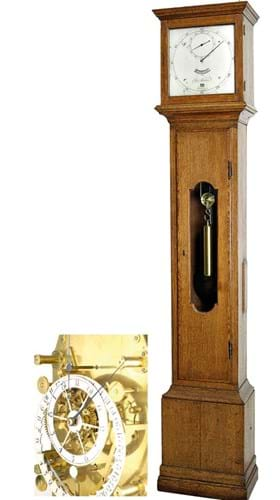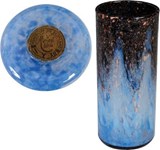
This example by George Graham, above, was originally delivered in 1738 to the Jesuit observatory in Vienna to be used to assist in astronomical observations. Numbered 756 for c.1737 (Graham was the successor to Thomas Tompion’s business and his accounting system), this is accordingly the fourth regulator built by Graham with a 30-day power reserve. It is thought that the grid-iron and brass pendulum is a later improvement with the bob being original to the timepiece.
Sold by German specialist horology auction house Dr Crott (25/22% buyer’s premium) on May 22 in Mannheim, it got away at the low end for expectations for €35,000 (£29,670).
Britain was the centre of clock and watch-making technology in the late 17th and early 18th centuries. And many cutting-edge creations made their way to illustrious clients in Europe.
Ferdinand VI (1713-59) became a key patron of Thomas Mudge (1715-94) after the Spanish monarch discovered he was the master behind an equation watch he owned by John Ellicott. Mudge is known to have made at least five watches for Ferdinand, including one that repeated the minutes as well as the quarters and hours and a repeater watch with an alarm designed to fit at the end of a cane.
Mudge movement
A Mudge movement watch with reputed Spanish royal connections was offered at Koller (25/22/15% buyer’s premium) in Zurich on June 30 where it sold to a UK dealer at SFr45,000 (£35,000).
Signed Tho. Mudge 422 and dated c.1758, it shows a complete display of the equation of time. It is later engraved Dedicado à D. Ramon Cabrera Sus admiradores (dedicated to Ramon Cabrera [1806-77] from his admirers) – a reference to a key figure in the First and Second Carlist Wars who later settled in Surrey. It is possible he acquired it during the tumult of the civil conflict that followed the death of Ferdinand VII in 1833.
David Penney, antiquarian horological consultant, believes the hammer price to be an auction record for a movement without a case. However, he added: “If this does turn out to have been made for Ferdinand VI, then the price would appear to have been more than reasonable.
“A similarly special movement by Mudge, No 366, also believed to have been made for the same Spanish customer, was purchased by the British Museum for a sum of around £100,000 in 1996.”















